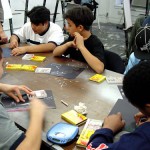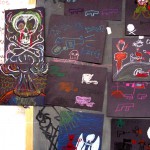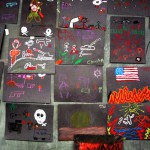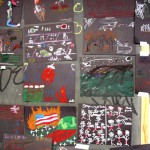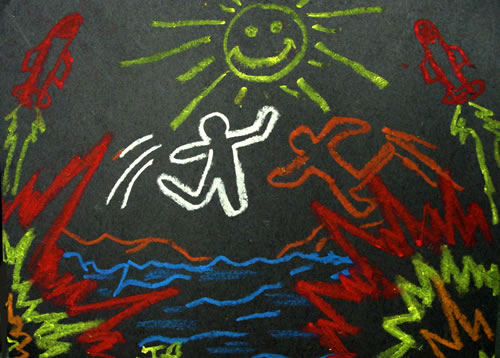
Categories
- Curriculum: Art | Computer | Language Arts
- Age/Grade: Elementary 3 | Middle School | Above 14
- Subject: Multi-Media | Drawing
- Materials: Mixed Media | Oil Pastels
- Institution: School of Visual Arts
- Location: New York, New York
- Duration: 2 - 3 Classes
Description
Using Haring's Subway Drawings as a starting point, this project emphasizes the use of personal icons and symbols through traditional drawing as well as computer-generated graphics.
Objective
Students will gain a familiarity with Keith Haring's subway drawings as well as graffiti art.
Students will learn to combine traditional media with computers to make a mixed media piece of art.
Students will expand vocabulary- symbols, semiotics, graffiti, radiant baby, tag, marquee tool, lasso tool, move tool, history brush tool, gradient tool, complementary color, analogous color...
Students will learn Adobe Photoshop skills- knowledge of the line tool, shape tool, and fill tool gradient tool as well as the layer, history and color bar.
Students will learn visual literacy skills: ability to observe, describe and interpret works of art.
Students will develop the ability to reflect him/herself by means of symbols.
Students will strengthen their ability to make artistic choices to communicate a specific idea.
Students will expand their understanding that art does not have to be a literal representation of a person, place, or thing, that symbols can communicate meaning about a person, place or thing.
Students will come to learn that Graffiti is a type of public art.
Resources
Keith Haring web sites
Keith Haring in the Subway
Subway Art, a lesson
Blinderman, Barry. Keith Haring Future Primeval. University Galleries of Illinois State University. IL 1990.
Sussman, Elizabeth. Keith Haring (Whitney Catalogue- OUT OF PRINT)
For Haring Exhibition catalogs- Call Pop Shop at 212.219.2784 to get a list of catalogs.
Materials
Charcoal
Computers
Adobe Photoshop 7.0 (any version should do)
Digital projector
8" x 14" Black paper
Chalk
Procedure
MOTIVATION
Images of subway drawings by Keith Haring as well as pictures of graffiti will be shown.
QUESTIONS
1. What's going on in this drawing?
2. What makes you say that?
3. Why do you think some one would choose to draw on a subway advertisement billboard?
4. What are some ways other than words that can say something about yourself?
5. How do you think the artist made this drawing?
6. Why would some one use chalk to draw instead of pencil or pen?
7. Compare an image of a graffiti piece with a subway drawing. What's similar? What is different?
PROCEDURE
Setting up before class: (10 mins.)
1. Make sure you have the black paper, chalk, white paper, and markers and pencils ready to hand out.
2. Arrange visuals in the order that you are going to discuss them.
Class time:
Introduction and discussion: (15 mins)
1. After students sit show subway drawing images by Keith Haring.
2. Using open-ended questions, engage the students in a class discussion about the artwork. The objectives of the discussion is to show how Keith Haring's subway drawings are similar to graffiti, how images can communicate a story, and how symbols can represent a person, place or thing.
Drawing Exercise: (15 mins)
1. Brainstorm different images that can represent particular person, place, or thing.
2. Students will be asked to experiment with the chalk to see how many different images that they can create for a specific thing.
Drawing Project (30 mins)
1. Students will create a drawing of symbols that they feel reflect him/herself using chalk and black paper.
2. Students will create another drawing using symbols that can be combined to tell a story.
3. Students will create a drawing (tag) of one symbol that they feel represents him/her the best.
After all three drawings are done they will be hung up on a wall and we will discuss them.
Demonstrate using Adobe Photoshop.
1. Using the computer that is hooked up to the digital projector so the contents of the computer can be viewed on the large screen, open a new document in Photoshop and show the different tools that can be used to make an image.
Student work on the assignment (60 mins)
1. The students will recreate their tag using Photoshop. The students will use the line tool, shape tool, and fill tool. Students will also learn about layers, color and history bars.
The finished pieces will be placed in a virtual city environment on a website.
Cleaning up: (5 mins)
1. Remind students to save their work on the computer.
2. Have students log off the computer.
SUMMARY
Have the students load their project so it is on the screen of their computer and have a class discussion about the pieces.
Extensions
Go here to find history and images of subway graffiti throughout the world.
NYS ARTS STANDARDS EMPLOYED
1. Creating, Performing and participating in the arts. Students will create a work of art using traditional media as well as on the computer.
2. Knowing and Using Arts Resources and Materials. Students will be familiar with making a drawing with chalk, and creating artwork with Adobe Photoshop.
3. Responding and Analyzing Works of Art. Students will actively engage in a class discussion by observing, describing and interpreting artworks by Keith Haring.
The author of this lesson, Wan Ling Li, a student of the School of Visual Arts in NYC, is the 2002-2003 scholarship recipient of the Keith Haring Scholarship award. This project was a collaboration with The School of Visual Arts & The Liberty Partnership Program* in New York City.
To find out more about The Keith Haring Foundation Scholarship offered through the School of Visual Arts, please contact:
Director, School of Visual Arts/Visual Arts Foundation, 15 Gramercy Park South, NYC 10003.
*The Liberty Partnership Program (LPP) is for students enrolled in 5th through 12th grades. LPP targets students who have been identified as being at-risk for dropping out of school because of poor academic performance, truancy, discipline, family circumstances, negative peer pressure and other documented factors.
